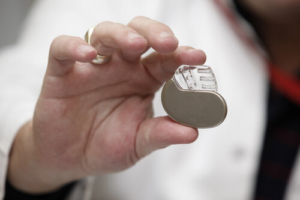Amiodarone side effects explained. If you or your loved one has been diagnosed with atrial fibrillation (AFib), you’re likely getting familiar with some new medications. One very commonly used medication is amiodarone.
Amiodarone has been around for quite some time. It’s a very effective medication for AFib, but it does carry some elevated risks of side effects as well as toxicity with long term use.
In this article we’re going to discuss some of the most commonly asked questions about amiodarone side effects and long-term toxicity.
What Is Amiodarone?
Amiodarone was created by Sanofi Pharmaceuticals and approved by the US Food and Drug Administration (FDA) on 12/24/1985.
Because it is an older drug, it is available in generic forms. It is also available in both IV form (for hospital use) and oral forms (for hospital or home use).
Amiodarone is frequently used to treat ventricular and atrial arrhythmias, including atrial fibrillation. It is used as an anti-arrhythmic to convert or prevent atrial fibrillation, and can also be used as a rate controlling agent to slow down the heart rate during AFib.
What Does Amiodarone Do in the Body?
Amiodarone is an antiarrhythmic drug. This means that it helps regulate the normal sinus rhythm to keep it regular, while attempting to convert or prevent arrhythmia episodes like atrial fibrillation.
Amiodarone is considered a class III antiarrhythmic drug. Drugs in this class work primarily by blocking the potassium channels which reduces the electrical excitability of the heart. This helps control unwanted heart rhythms.
Unlike other class III drugs, amiodarone also affects beta-adrenergic receptors (e.g., beta-1), calcium channels, and sodium channels. These contribute to the drug’s ability to regulate the normal heart rhythm but also may increase some of amiodarone’s side effects risk.
How Much Amiodarone Is Too Much?
The dosing of this medicine will be different depending on the patient.
In general, a higher dosage is associated with a higher risk of side effects. Never take more than the dose prescribed by your doctor as that could be life threatening.
There are studies that support doses of 400mg a day or more can lead to a significant increase risk for long-term toxicity from amiodarone.
What Are the Common Amiodarone Side Effects?
All medications have the possibility of side effects. Some of the most common side effects are listed below.
Amiodarone side effects that don’t usually need medical attention:
● Constipation
● Headache
● Loss of appetite
● Nausea
● Vomiting
Common amiodarone side effects that may be more serious:
● Cough
● Dizziness, lightheadedness, or fainting
● Slight fever
● Weakness of the legs or trouble walking
● Weakness of the arms or shaky hands
● Numbness or tingling in the fingers or toes
● Painful breathing
● Sun sensitivity of the skin
● Unusual and uncontrolled movements of the body
If you think that you are experiencing any side effects from amiodarone, contact your doctor.
Amiodarone also contains iodine and should not be used by people with an iodine hypersensitivity.
Cardiac Side Effects of Amiodarone
Up to 10% of patients may develop low blood pressure due to amiodarone. Anywhere from 1-10% of patients may also develop a heart rate that is too slow due to the medication.
Amiodarone can also increase risk for abnormal heart rhythms from the ventricle, called ventricular tachycardia. This is due to the risk of prolonging the natural time for a heartbeat to reset, a phenomenon called QT prolongation.
What Are the Potential Long Term Side Effects of Amiodarone?
Amiodarone is a very effective medication, but it does carry a risk of toxicity to various organs in the body. These risks increase for patients who use the medication for a long time or who need high doses to control their heart rhythm.
Lung
Pulmonary toxicity is one of the most dangerous potential side effects from amiodarone. Several forms of lung disease have been noted in patients taking amiodarone. These are most likely to happen in patients taking the medication for several months (1-5% of patients depending on the dose). Lung toxicity is also more likely to happen in patients taking higher doses of the medication (more than 400mg per day).
Liver
Liver injury from amiodarone is uncommon but not rare. It can happen in up to 1% of patients annually. It is recommended that you have your liver functions tested before you begin therapy and every 6 month afterward. If your liver function blood tests get too high, you may have to stop taking amiodarone.
Thyroid
Amiodarone therapy can also cause problems with the thyroid. This can be either an overactive or underactive thyroid, although underactive (hypothyroid) is more common. Your doctor will liekly monitor your thyroid levels before and during your use of amiodarone. You may also need to take medication to correct an unbalanced thyroid. Rates of amiodarone induced hypthyroidism can rage from 5-22% in some studies.
Ocular
Amiodarone toxicity may also affect vision and lead to corneal micro-deposits. Over 10% of patients on amiodarone may develop visual disturbance due to the medication.
Nervous system
There are a variety of nervous system abnormalities that have been reported due to amiodarone which include tremors, lack of coordination, dizziness, headache, and abnormal taste and smell. Anywhere from 1% to 10% of patients on amiodarone may develop symptoms of nervous system toxicity.
How Long Do the Side Effects of Amiodarone Last?
Amiodarone has a very long half life (the time it takes the body to eliminate half of the drug that is in the body).
It can take 1-3 months for effects to end if you stop taking this drug. This means that if you stop taking the drug for any reason, the side effects could continue for some time until the drug fully leaves your body.
What Should Be Avoided When Taking Amiodarone?
There are several things to avoid when taking amiodarone. These precautions help to lower the risk of experiencing unwanted effects. Here are some of the most common.
Avoid Grapefruit and Grapefruit Juice
Eating grapefruit or drinking grapefruit juice can increase the amount of amiodarone that is absorbed into your body. This can increase your risk of side effects and toxicity.
Avoid St John’s Wort
Taking the herbal supplement St John’s Wort can lower the amount of amiodarone that your body is able to absorb. This can mean it does not work as well and your AFib won’t be controlled.
Practice Sun Safety
Photosensitivity or being more sensitive to the sun than usual is a common side effect of amiodarone. You might also experience a blue-gray coloring of your skin in areas exposed to the sun. Minimize exposure to the sun, use sunscreen and protective clothing, and avoid sun lamps or tanning beds while taking amiodarone.
The Guide To Reverse Atrial Fibrillation Naturally
If you are interested in natural treatment options for atrial fibrillation and are highly motivated in improving your symptoms naturally, to reduce your need for medications or even procedures, then take a look at my one-of-a-kind, online educational program, Take Control Over AFib.
Lifestyle modifications and reducing inflammation are essential components of the long-term management of atrial fibrillation. Addressing the source cause of atrial fibrillation can lead to a significant benefit for most AFib patients. Targeted lifestyle modifications can reduce your symptoms, reduce your reliance on medications or procedures, and even improve the long-term success rate of procedures for AFib. However, most patients are not given instructions or tips on how to accomplish these essential lifestyle modifications in an AFib targeted style.
This is exactly why I created the Take Control Over AFib Program, to give people a step-by-step plan to improve and potentially reverse atrial fibrillation naturally.
Thinking about lifestyle modifications is easy, but putting in place a system to keep you committed to achieve real results takes time and dedication, and with my step-by-step plan, we can achieve powerful and long-lasting results together.
Learn More About The Take Control Over AFib Program Here
Final Thoughts
Amiodarone is a commonly used drug to treat heart rhythm problems like atrial fibrillation.
Its considered very effective but it does come with a significant risk of amiodarone side effects and amiodarone toxicity. These can be potentially very serious.
There are times when amiodarone can be very useful in urgent settings or for short-term use. Usually over time I decrease the doseage for my patients and try to wean it off completely within a few months. If I feel like it cannot be safely stopped without causing significant recurrent atrial fibrillation, I frequently look for alternative anti-arrhythmic medications with lower side effects, or I may consider procedures such as a catheter ablation to improve symptoms without medications.
You can lessen your risks or amiodarone side effects with close monitoring and frequent communication with your doctor. In general, the lowest effective dose of amiodarone should be used for the shortest duration needed.
As always, report any side effects of your medication to your doctor immediately.
The Best Atrial Fibrillation Book
Your Complete Guide To AFib: The Essential Manual For Every Patient With Atrial Fibrillation
$15.95 (as of April 28, 2024 10:33 GMT -06:00 - More infoProduct prices and availability are accurate as of the date/time indicated and are subject to change. Any price and availability information displayed on [relevant Amazon Site(s), as applicable] at the time of purchase will apply to the purchase of this product.) The A to Z guide on everything you need to know about atrial fibrillation. Written by AFib expert Dr. Percy Morales MD. Over 120 pages of essential information on medications, procedures, and lifestyles modifications for AFib. Easy to read for every patient.
Shop AFib Products on Amazon
KardiaMobile 6-Lead Personal EKG Monitor – Six Views of The Heart – Detects AFib and Irregular Arrhythmias – Instant Results in 30 Seconds – Works with Most Smartphones - FSA/HSA Eligible

KardiaMobile 1-Lead Personal EKG Monitor – Record EKGs at Home – Detects AFib and Irregular Arrhythmias – Instant Results in 30 Seconds – Easy to Use – Works with Most Smartphones - FSA/HSA Eligible

Apple Watch Series 9 [GPS 41mm] Smartwatch with Storm Blue Aluminum Case with Silver Sport Band M/L. Fitness Tracker, Blood Oxygen & ECG Apps, Always-On Retina Display

Fitbit Sense 2 Advanced Health and Fitness Smartwatch with Tools to Manage Stress and Sleep, ECG App, SpO2, 24/7 Heart Rate and GPS, Shadow Grey/Graphite, One Size (S & L Bands Included)

OMRON - Complete Wireless Upper Arm Blood Pressure Monitor + EKG - Built-in Bluetooth Technology

Omron Hem 7361T Bluetooth Digital Blood Pressure Monitor with Afib Indicator and 360° Accuracy Intelliwrap Cuff for Most Accurate Measurements (White)

EMAY Portable ECG Monitor | Record ECG and Heart Rate Anytime Anywhere | Stand-Alone Device with LCD Screen and Storage | No Subscription Required

Samsung Galaxy Watch 6 44mm Smartwatch with HR Zones, Sleep Coaching, Heart Monitor - Graphite

Natural Rhythm Triple Calm Magnesium 150 mg - 120 Capsules – Magnesium Complex Compound Supplement with Magnesium Glycinate, Malate, and Taurate. Calming Blend for Promoting Rest and Relaxation.

Pure Encapsulations Magnesium (Glycinate) - Supplement to Support Stress Relief, Sleep, Heart Health, Nerves, Muscles, and Metabolism* - with Magnesium Glycinate - 180 Capsules


















![Apple Watch Series 9 [GPS 41mm] Smartwatch with Storm Blue Aluminum Case with Silver Sport Band M/L. Fitness Tracker, Blood Oxygen & ECG Apps, Always-On Retina Display #1](https://m.media-amazon.com/images/I/311xwtp4mFL._SL100_.jpg)
![Apple Watch Series 9 [GPS 41mm] Smartwatch with Storm Blue Aluminum Case with Silver Sport Band M/L. Fitness Tracker, Blood Oxygen & ECG Apps, Always-On Retina Display #2](https://m.media-amazon.com/images/I/41j+8AaUGsL._SL100_.jpg)
![Apple Watch Series 9 [GPS 41mm] Smartwatch with Storm Blue Aluminum Case with Silver Sport Band M/L. Fitness Tracker, Blood Oxygen & ECG Apps, Always-On Retina Display #3](https://m.media-amazon.com/images/I/41jIyxZitnL._SL100_.jpg)
![Apple Watch Series 9 [GPS 41mm] Smartwatch with Storm Blue Aluminum Case with Silver Sport Band M/L. Fitness Tracker, Blood Oxygen & ECG Apps, Always-On Retina Display #4](https://m.media-amazon.com/images/I/41IpNJERjCL._SL100_.jpg)
![Apple Watch Series 9 [GPS 41mm] Smartwatch with Storm Blue Aluminum Case with Silver Sport Band M/L. Fitness Tracker, Blood Oxygen & ECG Apps, Always-On Retina Display #5](https://m.media-amazon.com/images/I/31o17yhfYpL._SL100_.jpg)

















































